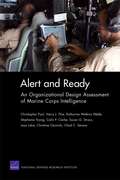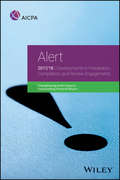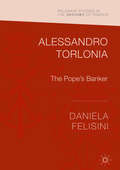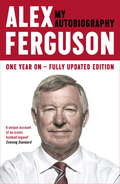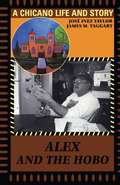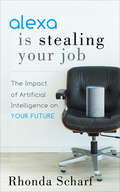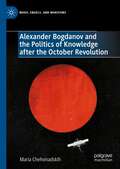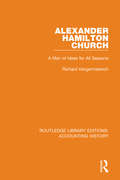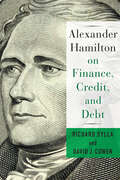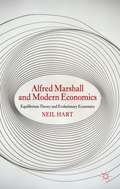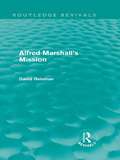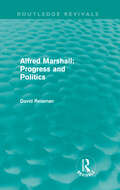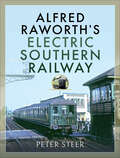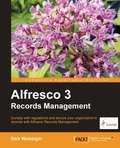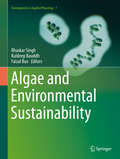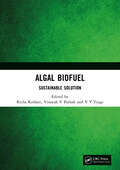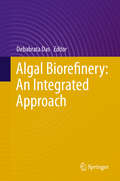- Table View
- List View
Alere
by Raffaella Sadun Catherine Slater Channing SpencerThe Board of Alere, Inc, a leading medical diagnostic firm, is evaluating the offer made by Ron Zwanziger, the firm's founder and former CEO, to acquire the company and take it private. The offer arrives at the end of a tumultuous year for the company, which saw Zwanziger fighting and ultimately losing a confrontation with activist investors Coppersmith Capital. How should the board evaluate this offer? Should they reject it, on the basis that Zwanziger's decision to expand into integrated healthcare solutions was the main reason behind the company's poor stock performance, as Coppersmith claimed? Or should they once more place their trust in Zwanziger's leadership, and in Alere's ability to effectively implement his vision?
Alert and Ready: An Organizational Design Assessment of Marine Corps Intelligence
by Christopher Paul Colin P. Clarke Harry J. Thie Stephanie Young Katharine Watkins WebbOver the past decade, especially, U.S. Marine Corps (USMC) intelligence has had to tailor its organization to meet the evolving demands of the operational environment. This has resulted in a number of ad hoc arrangements, practices, and organizations. A broad review of the organizational design of USMC intelligence examined how to align it efficiently and effectively with current and future missions and functions.
Alert: Developments in Preparation, Compilation, and Review Engagements, 2017/18
by AicpaThis annual Alert covers the latest developments in the preparation, compilation and review engagements, including current exposure drafts from Accounting and Review Services Committee (ARSC), and common deficiencies identified during peer reviews. Reviewed by ARSC chair, it also addresses the latest and emerging practice issues, and provides valuable information regarding accounting and reporting developments. Key benefits of this title include: Discussion of two new exposure drafts. Current practice issues in SSARS engagements. Ethics updates. Peer review common findings. Additional SSARS engagement resources
Alessandro Torlonia: The Pope’s Banker (Palgrave Studies in the History of Finance)
by Daniela FelisiniThis book provides a vivid biography of a towering Italian banker, pioneer and entrepreneur. It weaves the entrepreneurial ventures of Alessandro Torlonia (1800-1886) through the narratives of business and politics in the Nineteenth century, the growth of European financial markets and the decline of Papal power during the Italian Risorgimento. The discussion is founded in rigorous historical research using original sources such as the Archivum Secretum Vaticanum papers and other official documents; the archives of the Torlonia family, and of the Rothschild bank in Paris; memoirs; correspondences, and newspapers. Through this book readers learn that Alessandro Torlonia was a man of many faces, who was one of the most complex and influential characters of Italian economic life in the nineteenth century. Felisini also provides an expert critique of the financial history of the papacy: an area of heightened interest given the notoriety of relations between the Holy See and its bankers in the twentieth and twenty-first centuries. Focal topics such as the history of European elites and the history of European financial markets will have an interdisciplinary appeal for scholars and researchers.
Alessi: Evolution of an Italian Design Factory (A)
by Youngme MoonAlessio Alessi, head of distribution at family-run Alessi S.p.A., is facing price and brand confusion among customers and is considering reorganizing Alessi's worldwide network of distributors. By describing the challenges facing Alessi, an internationally acclaimed design and manufacturing company of household objects for the table and kitchen, the case examines consumer marketing and distribution in general, as applied in the niche market of highly designed household goods for an Italian design factory. Includes color exhibits.
Alex Atala: Bringing Brazil to the World
by Boris Groysberg Priscilla Zogbi Ruth CostasBrazilian Michelin-star chef Alex Atala managed four restaurants, a foundation advocating for the environment, and a seminar focused on food and sustainability. His new initiative was opening a hotel.
Alex Ferguson: My Autobiography
by Alex FergusonSir Alex announced his retirement as manager of Manchester United after 27 years in the role. He has gone out in a blaze of glory, with United winning the Premier League for the 13th time, and he is widely considered to be the greatest manager in the history of British football. <P><P>Over the last quarter of a century there have been seismic changes at Manchester United. The only constant element has been the quality of the manager's league-winning squad and United's run of success, which included winning the Champions League for a second time in 2008. <P>Sir Alex created a purposeful, but welcoming, and much envied culture at the club which has lasted the test of time. Sir Alex saw Manchester United change from a conventional football club to what is now a major business enterprise, and he never failed to move with the times. It was directly due to his vision, energy and ability that he was able to build teams both on and off the pitch. He was a man-manager of phenomenal skill, and increasingly he had to deal with global stars. <P><P>His relationship with Cristiano Ronaldo, for instance, was excellent and David Beckham has described Sir Alex as a father figure. Over the past four years, Sir Alex has been reflecting on and jotting down the highlights of his extraordinary career and in his new book he will reveal his amazing story as it unfolded, from his very early days in the tough shipyard areas of Govan.
Alex Montana at ESH Manufacturing Co.
by Thomas J. Delong Michael KernishAlex Montana sat at his desk pondering the career decision before him. Alex was director of the North American division of ESH Manufacturing, a $4.6 billion, Cleveland-based company with operations on three continents. ESH's CEO had just offered Montana a promotion to global vice-president. Normally, Montana would have jumped at such an opportunity, but he worried about its impact on his already strained personal life. Since his last promotion, he had trouble balancing an increasingly demanding workload with his responsibilities to his wife and daughter at home. Montana felt pressure to accept the promotion. His boss expected him to accept; in fact, his boss had emphasized that he had no second choice. He had always dreamed of making it big in the business world. Success in this new role could put him in the running for COO and, eventually, CEO. But at what cost?
Alex and the Hobo: A Chicano Life and Story
by Taylor James M. Taggart José InezWhen a ten-year-old boy befriends a mysterious hobo in his southern Colorado hometown in the early 1940s, he learns about evil in his community and takes his first steps toward manhood by attempting to protect his new friend from corrupt officials. Though a fictional story, Alex and the Hobo is written out of the life experiences of its author, José Inez (Joe) Taylor, and it realistically portrays a boy's coming-of-age as a Spanish-speaking man who must carve out an honorable place for himself in a class-stratified and Anglo-dominated society. In this innovative ethnography, anthropologist James Taggart collaborates with Joe Taylor to explore how Alex and the Hobo sprang from Taylor's life experiences and how it presents an insider's view of Mexicano culture and its constructions of manhood. They frame the story (included in its entirety) with chapters that discuss how it encapsulates notions that Taylor learned from the Chicano movement, the farmworkers' union, his community, his father, his mother, and his religion. Taggart gives the ethnography a solid theoretical underpinning by discussing how the story and Taylor's account of how he created it represent an act of resistance to the class system that Taylor perceives as destroying his native culture.
Alexa Is Stealing Your Job: The Impact of Artificial Intelligence on Your Future
by Rhonda ScharfThis guided tour of how AI will impact the future of work explores the ways both companies and employees can adapt to the new normal. Artificial intelligence is taking over. Ask Alexa to call a client or confirm your schedule for the day and she does so immediately. Ask her a question, give her a command, or just share a joke together, and she becomes your new best employee—one who never makes a mistake or calls out sick. In other words, Alexa can nix the need for millions of front-line workers. As companies race to keep up with advances in AI, employees must race just to keep their job. Author and public speaker Rhonda Scharf shows readers how a willingness to adapt to the new normal keeps both businesses and their employees relevant in these changing times. Alexa Is Stealing Your Job reveals what the future entails by diving into the world of AI and exploring how it impacts lives, careers, and the future.
Alexander Bandelli (A)
by Thomas J. Delong Catherine ConneelyAlexander Bandelli has the opportunity to redefine the way real estate business is done in the Northeast region. He has just joined Ronsini and Fitch and has been asked by senior management to move to a client focus rather than the older, traditional transaction focus. Alexander has many challenges before him. How should he prioritize his work? Does he focus outside the organization or internally? Is the organization prepared for this change project? What should he do first?
Alexander Bogdanov and the Politics of Knowledge after the October Revolution (Marx, Engels, and Marxisms)
by Maria ChehonadskihIn this book, Maria Chehonadskih unsettles established narratives about the formation of a revolutionary canon after the October Revolution. Displacing the centre of gravity from dialectical materialism to the rapid dissemination, canonisation and decline of a striking convergence of empiricism and Marxism, she explores how this tendency, overshadowed by official historiography, establishes a new attitude to modernity and progress, nature and environment, agency and subjectivity, party and class, knowledge and power. The book traces the adventure of the synthesis of empiricism and Marxism across philosophy, science, politics, art and literature from the 1890s to the 1930s, offering a radical rethinking of the true scope and scale that the main proponent of Empirio-Marxism, Alexander Bogdanov, had on the post-revolutionary socialist legacies. Chehonadskih draws on both key and forgotten figures and movements, such as Proletkult, Productivism and Constructivism, filling a gap in the literature that will be particularly significant for Marxism, continental philosophy, art theory and Slavic studies specialists.
Alexander Hamilton Church: A Man of Ideas for All Seasons (Routledge Library Editions: Accounting History #6)
by Richard VangermeerschThis book, first published in 1988, reassesses the data on Church – accountant, manager and industrial engineer – and stresses the theoretical impact of his ideas upon contemporary business structures as well as his practical desire to implement concepts to better the working man’s day. The past impact of engineers and engineering concepts on accounting and management has previously been overlooked, and this book corrects this. The discussion herein may inspire a much-needed dialogue among engineers, accountants and managers.
Alexander Hamilton on Finance, Credit, and Debt
by David Cowen Richard SyllaWhile serving as the first Treasury Secretary from 1789 to 1795, Alexander Hamilton engineered a financial revolution. Hamilton established the Treasury debt market, the dollar, and a central bank, while strategically prompting private entrepreneurs to establish securities markets and stock exchanges and encouraging state governments to charter a number of commercial banks and other business corporations. Yet despite a recent surge of interest in Hamilton, U.S. financial modernization has not been fully recognized as one of his greatest achievements.This book traces the development of Hamilton's financial thinking, policies, and actions through a selection of his writings. <P><P>The financial historians and Hamilton experts Richard Sylla and David J. Cowen provide commentary that demonstrates the impact Hamilton had on the modern economic system, guiding readers through Hamilton's distinguished career. The book showcases Hamilton’s thoughts on the nation's founding, the need for a strong central government, confronting problems such as a depreciating paper currency and weak public credit, and the architecture of the financial system. His great state papers on public credit, the national bank, the mint, and manufactures instructed reform of the nation’s finances and jumpstarted economic growth. Hamilton practiced what he preached: he played a key role in the founding of three banks and a manufacturing corporation, and his deft political maneuvering and economic savvy saved the fledgling republic's economy during the country's first full-blown financial crisis in 1792. Sylla and Cowen center Hamilton's writings on finance among his most important accomplishments, making his brilliance as an economic policy maker accessible to all interested in this Founding Father's legacy.
Alexander Hamilton on Finance, Credit, and Debt
by Richard Sylla David J. Cowen&“A treasure trove for financial and public policy geeks . . . will also help lay readers go beyond the hit musical in understanding Hamilton&’s lasting significance.&” —Publishers Weekly While serving as the first treasury secretary from 1789 to 1795, Alexander Hamilton engineered a financial revolution. He established the treasury debt market, the dollar, and a central bank, while strategically prompting private entrepreneurs to establish securities markets and stock exchanges and encouraging state governments to charter a number of commercial banks and other business corporations. Yet despite a recent surge of interest in Hamilton, US financial modernization has not been fully recognized as one of his greatest achievements. This book traces the development of Hamilton&’s financial thinking, policies, and actions through a selection of his writings. Financial historians and Hamilton experts Richard Sylla and David J. Cowen provide commentary that demonstrates the impact Hamilton had on the modern economic system, guiding readers through Hamilton&’s distinguished career. It showcases Hamilton&’s thoughts on the nation&’s founding, the need for a strong central government, problems such as a depreciating paper currency and weak public credit, and the architecture of the financial system. His great state papers on public credit, the national bank, the mint, and manufactures instructed reform of the nation&’s finances and jumpstarted economic growth. Hamilton practiced what he preached: he played a key role in the founding of three banks and a manufacturing corporation—and his deft political maneuvering and economic savvy saved the fledgling republic&’s economy during the country&’s first full-blown financial crisis in 1792. &“A fascinating examination of Hamiltonian economics.&” —The Washington Times
Alexander Hamilton's Economic Plan: Solving Problems In America's New Economy (Primary Sources Of Life In The New American Nation Ser.)
by Ryan P. RandolphAlexander Hamilton's Economic Plan: Solving Problems in America's New Economy
Alfred Marshall and Modern Economics
by Neil HartAlfred Marshall and Modern Economics demonstrates that it is possible to take Marshall's theoretical insights in two distinctly different directions: one is to reject evolution and go down the equilibrium path, while the second is to reject equilibrium and go down the evolutionary path. Neil Hart re-examines Marshall's legacy and relevance to modern economic analysis with the more settled conventional wisdom concerning evolutionary processes allowing advances in economic theorising which were not possible in Marshall's life time. A more theoretically coherent and relevant approach to modern economic analysis is proposed by connecting aspects of Marshall's revitalised evolutionary economics with Post-Keynesian theories, in a manner which parallels Marshall's endeavour to maintain a unity between value theory and explanations of industry organisation and economic development. This book will be essential reading for all researchers and students interested in the history of economic thought.
Alfred Marshall's Mission (Routledge Revivals)
by David ReismanAlfred Marshall was anxious to do good. Intended by an Evangelical father for the vocation of clergyman, the author of the mould-shaping Principles of Economics remained to the end of his days a great preacher deeply committed to raising the tone of life. First published in 1990, Alfred Marshall’s Mission explains how this most moral of political economists sought to blend the downward sloping utility function of Jevons and Menger with the organic evolutionism of Darwin and Spencer, how this celebrated theorist of social alongside economic growth sought to combine the mathematical marginalism of Cournot. Thunen and Edgeworth with the ethical uplift of Green, Jowett and Toynbee. The conclusion reached is that perhaps Marshall was, after all, too anxious to do good. Far more economists, however, have been not anxious enough; and that in itself gives this study of Marshall’s life and times a present day relevance which would, no doubt, have appealed strongly to the shy Cambridge professor who is its subject.
Alfred Marshall: Progress And Politics (Routledge Revivals)
by David ReismanFirst published in 1987, Alfred Marshall: Progress and Politics provides an enlightening insight into Marshall's thoughts on social improvement, adaptive upgrading, policy and polity. He planned books on these subjects which he never subsequently wrote, but the thesis of this work is that a close study of such writings as Marshall did complete makes possible a very detailed reconstruction of the important contribution which Marshall was capable of making to Victorian evolutionary thought (much in the shadow of Darwin and Spencer). In the ongoing debate on the political element in political economy, he reveals himself to have been as much an eclectic as was Adam Smith and as much a man of commitment as was T. H. Green.
Alfred Raworth's Electric Southern Railway
by Peter SteerThe Southern Railway between 1923 and 1939 was the only British company to carry out a sustained programme of electrification which became known as the Southern Electric. Unlike many recent projects, each incremental step was completed on time and within budget. This successful project was more impressive as it was achieved during a period of economic stagnation (including the ‘great depression’) and despite government disapproval of the method of electrification. The driving force behind this endeavor was the railway’s general manager, Sir Herbert Walker, but at his side was his electrical engineer, Alfred Raworth, the man one journalist described as an ‘electrification genius’. Alfred Raworth’s career began working with his father the eminent consulting engineer and entrepreneur, John Smith Raworth. Following the collapse of his father’s business Alfred joined the railway industry and devised an ambitious and innovative electrification design. This was discarded when the railways of southern England were ‘grouped’ into the Southern Railway after which he took responsibility for the implementation of the electrification schemes. With Walker’s retirement in 1937, those who continued to support steam traction took the policy lead. A marginalised Raworth retired but was later to witness the fruition of many of his discarded ideas.
Alfresco 3 Records Management
by Dick WeisingerThis book is structured in a sequential way that walks you through the steps necessary to set up your Alfresco Records Management system. Chapters follow a logical progression with each chapter building on the knowledge and implementation details learned in earlier chapters.If you are a records manager, business analyst, or a software developer, and want to implement the Alfresco Records Management program for your organization, then this book is for you. You don't require any prior knowledge of Alfresco Share software to follow this book.
Algae and Environmental Sustainability (Developments in Applied Phycology #7)
by Faizal Bux Bhaskar Singh Kuldeep BauddhThis book presents the dynamic role of algae in a sustainable environment. Two major aspects, namely bioenergy and bioremediation, have been elaborated in various chapter contributed by scientists and teachers from different geographical areas throughout the world. Algal biofuels is an emerging area of equal interest to researchers, industries, and policy makers working or focusing on alternative (i. e. renewable) fuels. Algae have been an area of interest due to their wide range of applications. Over the last 5 decades, eukaryotic algae have been used in the aquaculture industry as feed for invertebrates, providing a rich source of antioxidants, dietary fiber, minerals and protein. More recently, there has been a focus on the use of algal biomass in the development of alternative fuels. The extraction of oil from algae has been widely explored as a much more viable feedstock than plant-based oils in large-scale fuel production. using algae as feedstock has the advantages that it doesn't require arable land and that wastewater can be used as a source of nutrients in their culture. The multifunctional approach of algae includes pollution remediation, carbon sequestration, biofuels production, and delivery of value-added products. However, there are still some obstacles that need to be overcome to make their use as potential feedstock for biofuels techno-economically feasible. In order to maintain the sustainability aspect of algal biofuels, various aspects have to be studied and critically analyzed to assess the long-term sustainability of algal derived biofuels. This book discusses the role of algae as a promising future feedstock for biofuels. They are known to sequester carbon in much larger amounts than plants and as such the book also describes their phycoremediation potential for conventional as well as emerging contaminants. It describes the role of anaerobic digestion in algal biorefineries; bioreactions and process parameters; biogas recovery and reuse. The role of algal biofilm based technology in wastewater treatment and transforming waste into bio-products is discussed, and remediation of sewage water through algae is assessed. The book also describes the production of biohydrogen, bio-oil, biodiesel; and the major bottlenecks in their usage. The emerging characterization techniques of these biofuels (bio-oil and biodiesel) are described, as are the decolorizing potential of algae and the genetic engineering techniques that could enhance the production of lipids in algae. Other aspects of the book include the role of remote sensing technology in the monitoring of algae and a life cycle assessment of algal biofuels.
Algal Biofuel: Sustainable Solution
by Richa Kothari V. V. Tyagi Vinayak V. PathakAlgal Biofuel: Sustainable Solution primarily focuses on the different aspects of bioenergy production using algal biomass as microalgae are considered the optimum feedstock for bioenergy production. The major aim is to thoroughly review the available bioenergy options, challenges in bioenergy production, availability of bioenergy feedstock, and biomass to bioenergy conversion process. This book also highlights the feasibility of lignocellulosic biomass, crop residues, and non-edible oil seeds for generation of different bioenergy products. It will be helpful for researchers and other stakeholders working in the area of bioenergy production for development of innovative concepts in emerging areas of bioenergy. Print edition not for sale in South Asia (India, Sri Lanka, Nepal, Bangladesh, Pakistan and Bhutan).
Algal Biorefinery: An Integrated Approach
by Debabrata DasThis book critically discusses different aspects of algal production systems and several of the drawbacks related to microalgal biomass production, namely, low biomass yield, and energy-consuming harvesting, dewatering, drying and extraction processes. These provide a background to the state-of-the-art technologies for algal cultivation, CO2 sequestration, and large-scale application of these systems. In order to tap the commercial potential of algae, a biorefinery concept has been proposed that could help to extract maximum benefits from algal biomass. This refinery concept promotes the harvesting of multiple products from the feedstock so as to make the process economically attractive. For the last few decades, algal biomass has been explored for use in various products such as fuel, agricultural crops, pigments and pharmaceuticals, as well as in bioremediation. To meet the huge demand, there has been a focus on large-scale production of algal biomass in closed or open photobioreactors. Different nutritional conditions for algal growth have been explored, such as photoautotrophic, heterotrophic, mixotrophic and oleaginous. This book is aimed at a wide audience, including undergraduates, postgraduates, academics, energy researchers, scientists in industry, energy specialists, policy makers and others who wish to understand algal biorefineries and also keep abreast of the latest developments.

